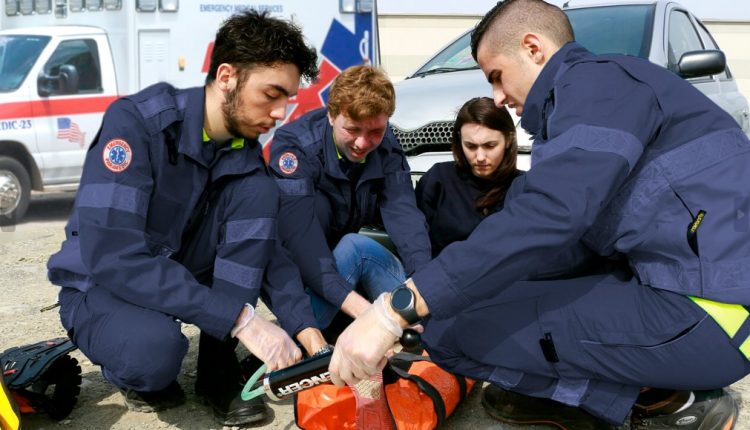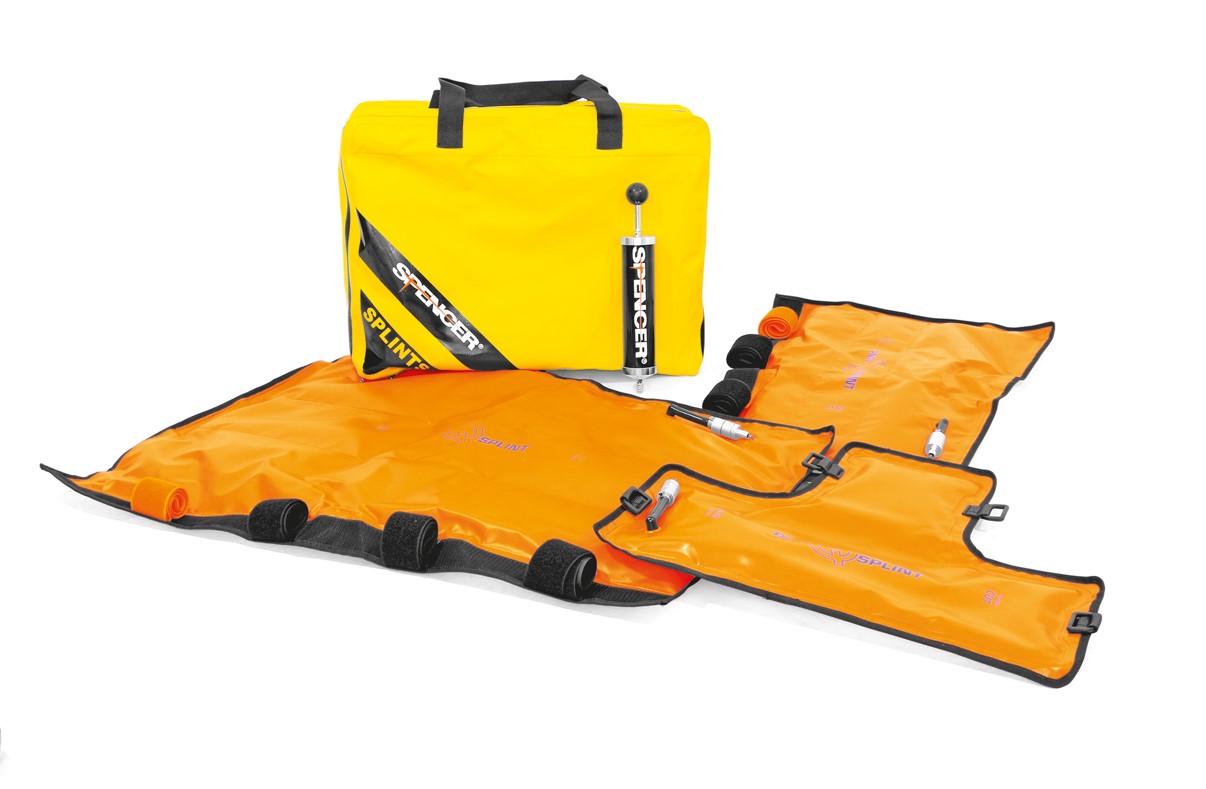
ເຄື່ອງດູດຝຸ່ນ: ອະທິບາຍຊຸດ Spencer Res-Q-Splint ແລະວິທີການໃຊ້ມັນ
The vacuum splint is a device which looks like a vacuum mattress of reduced dimensions, it is used in emergency medicine for the immobilisation of traumatised limbs and as a temporary splint
Splints work by extracting the air from the splint itself, which then assumes the shape and rigidity required to stabilise the limb injury, be it trauma, joint dislocation, subluxation or fracture.
The splint kit you will find in your ambulance
Before explaining in detail how to use these vacuum splints, let’s see what a ຊຸດ Res-Q-Splint ໂດຍ Spencer contains and when the various emergency splints are used.
The bag, which is always placed in an dedicated compartment in a standard ambulance, has a pocket in which the suction pump is placed.
This is an essential aid: the pump has the specific purpose of depressing the splints by sucking the air out of them.
The Res-Q-Splint Kit bag contains three splints of different size and function
- The small splint has the primary function of protecting the wrist and hand.
- The medium splint has the primary function of providing protection to the upper limbs.
- The large splint has the primary function of providing protection to the lower limbs, and a secondary function as an emergency vacuum mattress for paediatric or neonatal patients.
Each splint is made of rubbery plastic material that can be washed and disinfected after each use.
Handling trauma patient with the Res-Q-Splint
The management of the trauma patient requires a range of skills, including scene management, choice of safe intervention procedures, risk assessment, patient assessment and treatment.
These skills are particularly relevant if the management of the trauma patient takes place in scenarios such as road accidents or rescue in maxi-emergencies (earthquakes, floods and, in winter, avalanches).
Vacuum splints are mainly used for the stabilisation and splinting of various forms of limb injuries.
Adequate levels of splinting are achieved through the correct sizing of the splint, the sculpting of the splint on the patient’s limb and the removal of excess air from the device.
![]() Splint application procedure
Splint application procedure
- First choose the splint from the ຊຸດ Res-Q-Splint suitable in form and function for the type of trauma observed on the patient: a correctly sized splint immobilises the joints above and below the site of injury.
- Lay the splint with the valve side down on a flat surface, manually distributing the beads of content evenly over the entire splint.
- Slide or position the splint under the injured area, positioning it so that at least one band is above and below the suspected lesion site.
- Support the splint and gently manipulate the beads to achieve the best possible conformal mould.
- Mould the splint cover.
- Connect the hand pump to the valve end – an audible ‘click’ will confirm correct positioning.
- Use the manual pump to evacuate air from the splint.
- Disconnect the valve and pump coupling by pressing the metal release tab on the pump connector.
- Fasten the splint straps with light tension around the splint.
- Check the patient’s distal blood circulation immediately after splint application. Recheck distal pulses and vital signs regularly throughout the duration of care.
In line with the standard guidelines for immobilisation – ‘immobilise the joint above and below the fracture and/or dislocation’ – the splint is indicated for use in:
- Knee dislocations
- Patella fractures
- fractures of the tibia and/or fibula
- Ankle and/or foot dislocation
- Ankle and/or foot fractures
- Fractures of the humerus (in combination with anatomical splints)
- ຂໍ້ສອກ dislocation
- Elbow fractures
- Fractures of the ulna and/or radius
- Wrist or hand dislocation
- Wrist or hand fractures
Femur fractures require the use of traction splints in specific cases, while NOF and ກະດູກສັນຫລັງ fractures benefit from the use of a vacuum mattress.
ການນໍາໃຊ້ຂອງ Res-Q-Splint is recommended in cases of suspected limb injuries or fractures, with the aim of avoiding further damage during pre-hospital rescue operations.
Watch the video tutorial on Res-Q-Splint splints by Spencer
ອ່ານຍັງໄດ້
ມີຊີວິດສຸກເສີນຫຼາຍຂຶ້ນ…ສົດ: ດາວໂຫລດແອັບຟຣີໃໝ່ຂອງໜັງສືພິມຂອງເຈົ້າສຳລັບ IOS ແລະ Android
ອຸປະກອນສຸກເສີນ: The Emergency Carry Sheet / VIDEO TUTORIAL
Spencer WOW, ມີຫຍັງຈະປ່ຽນແປງໃນການຂົນສົ່ງຄົນເຈັບ?
Tango Spencer, ຄະນະ ກຳ ມະການກະດູກສັນຫຼັງຄູ່ທີ່ຊ່ວຍໃຫ້ການຍ່ອຍສະຫຼາຍໄດ້ດີຂື້ນ
ກະເປົ໋າເປ້ສຸກເສີນ MERET, Catalog ຂອງ Spencer ອຸດົມໄປດ້ວຍສິ່ງທີ່ດີເລີດຕື່ມອີກ
ແຜ່ນໂອນສຸກເສີນ QMX 750 Spencer Italia, ເພື່ອການຂົນສົ່ງຄົນເຈັບທີ່ສະດວກສະບາຍ ແລະປອດໄພ
Cervical And Spinal Immobilization Techniques: ພາບລວມ
ກະດູກສັນຫຼັງ Immobilization: ການປິ່ນປົວຫຼືການບາດເຈັບ?
10 ບາດກ້າວໃນການປະຕິບັດການແກ້ໄຂກະດູກສັນຫຼັງທີ່ຖືກຕ້ອງຂອງຄົນເຈັບທີ່ເປັນໂຣກເຈັບ
ການບາດເຈັບຂອງຖັນກະດູກສັນຫຼັງ, ຄຸນຄ່າຂອງກະດານກະດູກ Rock / Rock Pin Max
Spinal Immobilisation, ຫນຶ່ງໃນເຕັກນິກການກູ້ໄພຕ້ອງເປັນແມ່ບົດ
ການບາດເຈັບໄຟຟ້າ: ວິທີການປະເມີນພວກເຂົາ, ສິ່ງທີ່ຕ້ອງເຮັດ
ການປິ່ນປົວ RICE ສໍາລັບການບາດເຈັບຂອງເນື້ອເຍື່ອອ່ອນ
ວິທີການປະຕິບັດການສໍາຫຼວດເບື້ອງຕົ້ນໂດຍໃຊ້ DRABC ໃນການປະຖົມພະຍາບານ
Heimlich Maneuver: ຊອກຫາວ່າມັນແມ່ນຫຍັງແລະເຮັດແນວໃດມັນ
ສິ່ງທີ່ຄວນຢູ່ໃນຊຸດປະຖົມພະຍາບານເດັກ
ພິດເຫັດພິດ: ຈະເຮັດແນວໃດ? ການເປັນພິດສະແດງອອກແນວໃດ?
ການເປັນພິດຂອງສານຕະກົ່ວແມ່ນຫຍັງ?
ພິດໄຮໂດຄາບອນ: ອາການ, ການວິນິດໄສ ແລະການປິ່ນປົວ
ການປະຖົມພະຍາບານເບື້ອງຕົ້ນ: ສິ່ງທີ່ຄວນເຮັດຫຼັງຈາກກືນກິນຫຼືການຮົ່ວໄຫຼຂອງສານຟອກຂາວໃສ່ຜິວຫນັງຂອງທ່ານ
ອາການແລະອາການຂອງອາການຊ໊ອກ: ວິທີການແລະເວລາທີ່ຈະແຊກແຊງ
Wasp Sting ແລະອາການຊ໊ອກ Anaphylactic: ສິ່ງທີ່ຕ້ອງເຮັດກ່ອນທີ່ລົດສຸກເສີນມາຮອດ?
ອັງກິດ / ຫ້ອງສຸກເສີນ, ການໃສ່ທໍ່ເດັກ: ຂັ້ນຕອນທີ່ມີເດັກຢູ່ໃນສະພາບຮ້າຍແຮງ
Intubation Endotracheal ໃນຄົນເຈັບເດັກນ້ອຍ: ອຸປະກອນສໍາລັບທາງອາກາດ Supraglottic
Sedation ແລະ Analgesia: ຢາເພື່ອອໍານວຍຄວາມສະດວກ intubation
Intubation: ຄວາມສ່ຽງ, ອາການສລົບ, ການຟື້ນຟູ, ເຈັບຄໍ
ຊ໊ອກກະດູກສັນຫຼັງ: ສາເຫດ, ອາການ, ຄວາມສ່ຽງ, ການວິນິດໄສ, ການປິ່ນປົວ, ການຄາດຄະເນ, ການເສຍຊີວິດ
ການຂັດຂວາງຖັນກະດູກສັນຫຼັງໂດຍໃຊ້ກະດານກະດູກສັນຫຼັງ: ຈຸດປະສົງ, ການຊີ້ບອກແລະຂໍ້ຈໍາກັດຂອງການນໍາໃຊ້
ການຂັດຂວາງກະດູກສັນຫຼັງຂອງຄົນເຈັບ: ເວລາໃດຄວນວາງກະດານກະດູກສັນຫຼັງ?
ຖົງແຜ່ນດິນໄຫວ, ເຄື່ອງສຸກເສີນທີ່ ຈຳ ເປັນໃນກໍລະນີເກີດໄພພິບັດ: ວີດີໂອ




